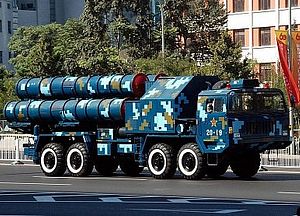Another deadline came and went at the end of April without a decision in Turkey’s drawn out effort to purchase a surface-to-air missile (SAM) with anti-missile capabilities. The Turkish Ministry of Defense announced its intention to purchase the Chinese HQ-9 system in September 2013. However, the bidding deadline has subsequently been extended three times, with the latest extension through the end of June allowing time to consider revised bids from Eurosam and the Raytheon/Lockheed Martin consortium.
The bid from the China Precision Machinery Import and Export Corporation (CPMIEC) appeared to meet all the criteria in Turkey’s tender. It came in $600 million under the asking price of $4 billion and the Chinese company offered co-production of the HQ-9, an important consideration for a Turkish government that aspires to develop its domestic defense industry. The HQ-9 system also reportedly tested well, exhibiting a capability to engage cruise missiles on a par with that of the Raytheon/Lockheed Martin Patriot system, and potentially a longer range for conventional air targets than the Patriot and Eurosam Aster 30 systems. Chinese media sources also reported that although the HQ-9 system has a shorter range than the Russian system, it has a faster response time (15 seconds) and it hit all nine of its targets in trials. Turkey felt confident that it could finalize the deal in six months (another deadline that passed in April) and was encouraged that the Chinese company offered the shortest timeline for delivery of the system. What went wrong?
The United States and other NATO countries expressed deep concern about the deal, raising questions about the security implications of CPMIEC system’s integration into NATO’s command and control network and the implications of Chinese technical knowledge about how U.S. and NATO air and missile defenses operate. U.S. and NATO leaders such as U.S. Secretary of State John Kerry and French Defense Minister Jean-Yves Le Drian have pressured Turkish leaders to change their minds. U.S. lawmakers also wrote a provision into the National Defense Authorization Act (NDAA) stating that no U.S. funds could be used to integrate Chinese missile defense systems into U.S. or NATO systems, a condition explicitly meant to encourage Turkey to backtrack from its decision to work with the Chinese.
Faced with higher than anticipated costs and under pressure from NATO and the United States, the Turkish government reopened bidding for the project several times. Successive extensions of the bidding deadline to January, then April, and now June 2014 have allowed time for U.S. and French-Italian companies to revise and resubmit their bids. Prospects for the HQ-9 dimmed further when Murad Bayar, undersecretary for the defense industry and the main proponent of the deal with China, was removed from his post within the Turkish Defense Ministry on March 27 and reassigned within the government.
If CPMIEC somehow perseveres and wins the contract, it would be a major success for the Chinese defense industry. This deal would mark China’s largest-ever military export sale and the first significant arms contract with a European country. Chinese arms exports have expanded significantly in recent years, with a 212 percent increase from 2009-2013 over 2004-2008. A completed deal could signal China’s ability to make significant inroads in the European and Middle Eastern arms sales markets.
Even if CPMIEC ultimately loses the deal, its success in the initial bidding highlights the progress China has made in missile and electronics capability. This was the first time that China demonstrated its ability to domestically develop and produce a long-range SAM and missile defense system with a quality comparable to that of the world leaders in defense technology. Airbus CEO Tom Enders expressed concern at China’s growing indigenous design and production capabilities, citing this near-deal and the development of advanced unmanned vehicles as evidence of China becoming “a serious competitor.”
Turkey appears unlikely to consummate the deal with CPMIEC, though it is unclear which Western company Turkey will ultimately choose. Raytheon/Lockheed Martin have offered to meet Turkey’s technology transfer requirement, but that would raise the price even further over Turkey’s $4 billion budget.
The drawn out process shows that China faces significant political and security barriers to entry into the European market from the United States and other NATO countries. This will be a significant obstacle for the Chinese defense industry going forward, especially in efforts to sell weapons to U.S. allies and close partners. On the other hand, CPMIEC’s success in winning the initial tender with an appealing combination of price, performance and technology transfer highlights the Chinese defense industry’s potential to compete with U.S. and European suppliers for third country markets where Western countries are less well placed to play the security card.
Denise Der is a research intern at the Center for the Study of Chinese Military Affairs, part of National Defense University’s Institute for National Strategic Studies, and a graduate student in the Security Studies Program at Georgetown University. The views expressed are those of the author and do not necessarily reflect those of the National Defense University, the Department of Defense or the United States Government.

































